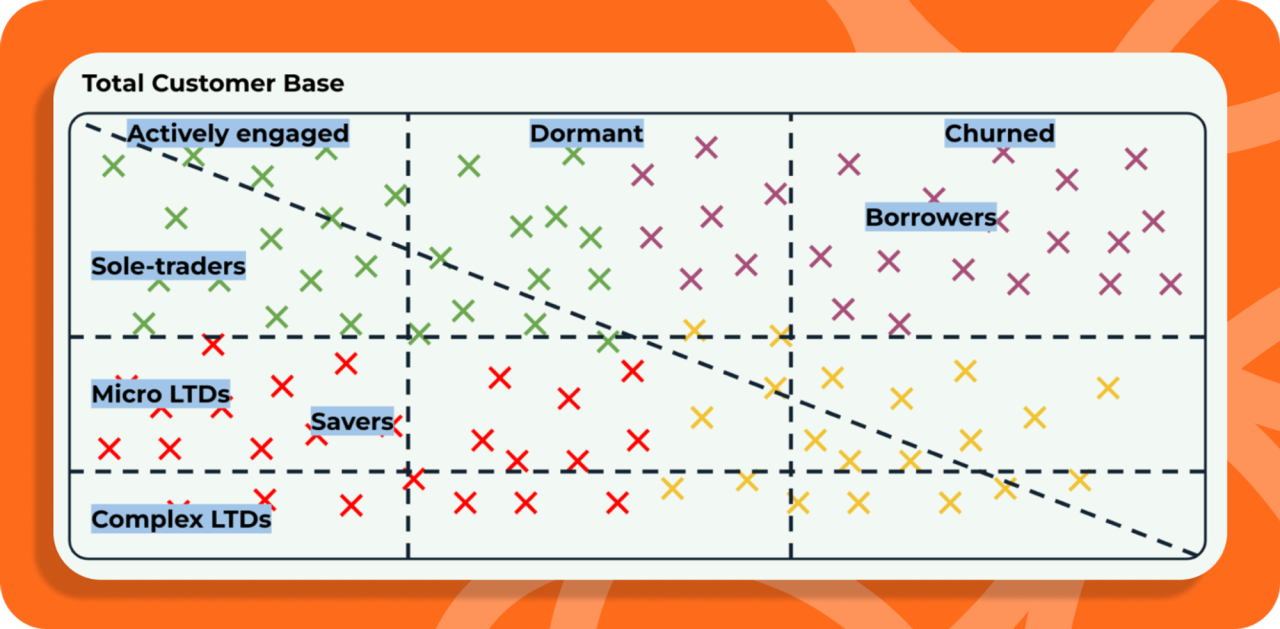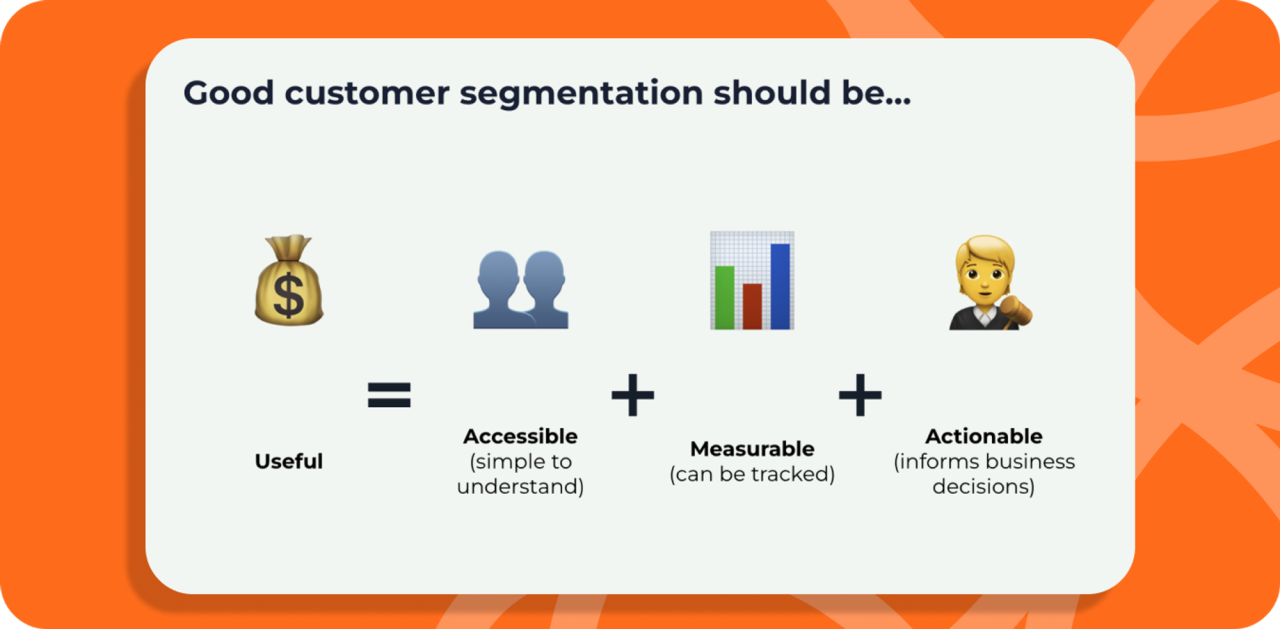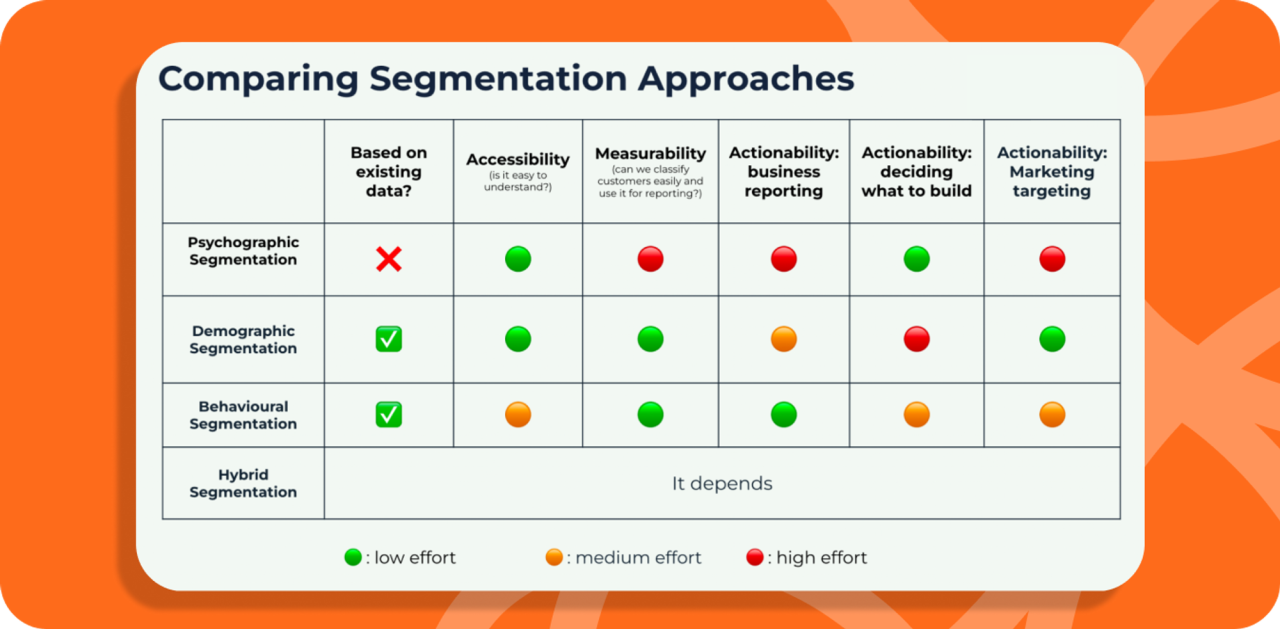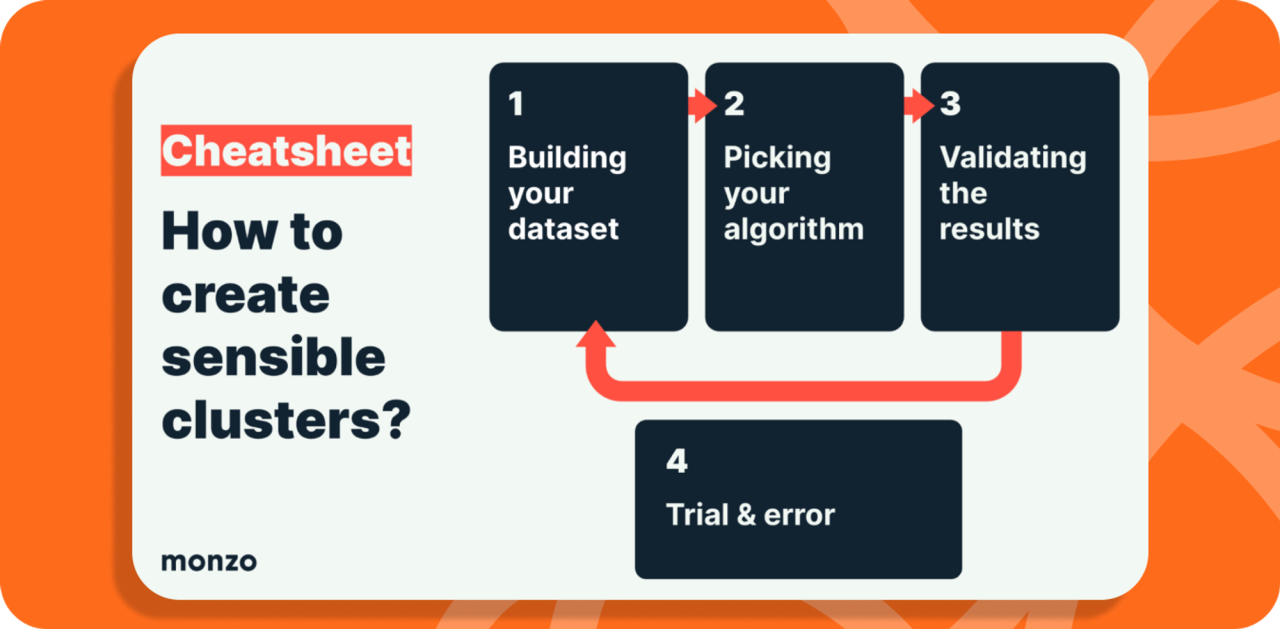Customer segmentation is the art of dividing customers into useful groups, but there are a lot of pitfalls to avoid along the way. Here is Monzo’s guide to help you decide your segmentation approach, collect the right data, divide them into sensible clusters, and validate your results. At the end, we included a case study on how we used Needs-based segmentation to formulate our product strategy in Monzo business banking.
Introduction
Customer segmentation is the process of dividing a customer base into groups, or segments, based on shared characteristics. These characteristics can include demographic information, such as age, gender, income level, and location, as well as behavioural data, such as purchase history, product preferences, and interests.
By dividing customers into segments and understanding them better, you can:
Build products and services to better meet the needs of each group
Create more targeted marketing campaigns that are more likely to be successful
Curate a more personalised product experience to increase customer engagement
What is segmentation?
To put simply, segmentation is the act of dividing up a base of customers (or viewers, potential clients, and anything else you wish to analyse) into groups that are useful to you. It’s a very powerful tool:
Product managers use it to decide which user problems to solve-for first, and how to solve them with the optimal product features.
Marketeers use it to optimise the time and place of marketing campaigns, as well as the tone of their messages
Biologists use it to classify the entire world’s living organisms
In essence, segmentation is our way of making sense of a very messy world. By dividing your customers into more organised groups, it can help us better understand, measure, and compare between the groups. Even though the resulting groups are often imperfectly defined (did you know that not all mammals are warm-blooded, and there are mammals that lay eggs?), the abstraction we purposely make is useful enough to justify the use.

What is the right segmentation approach for me?
In order to get the most use out of your segmentation, it is important to be razor focused on the main objective you are trying to achieve.
One common pitfall with segmentation projects is that we get too greedy. Your CEO wants to know which features will solve the biggest pain point; your performance marketing manager wants to use it to create ads that resonate the most with your target audience; and your product manager wants to understand how your customers are engaging with your product. Although segmentation can be used to answer all of these questions individually, trying to answer all of them at once will likely be a disaster. You will end up with segments that are poorly separated, and are hard to interpret - results that are not useful to anyone.

Because the word segmentation is associated with so many things, it is crucial to align with your stakeholders on exactly what your business objectives are. And if there are too many goals to feasibly deliver in one project, it is worth doing a prioritisation exercise with your stakeholders in order to narrow down the scope.

The main segmentation approaches and when to use them
When your business goal is focused and clear, it is now the time to pick your segmentation approach.
There are many ways to divide your customer base into groups, each optimised for a given purpose. Limited by length, we will discuss the 4 most common segmentation approaches below:
Psychographic segmentation
Demographic segmentation
Behavioural segmentation
Hybrid segmentation
We will then discuss the pros and cons of each approach based on a few dimensions:
Ease of data collection
Accessibility (ease to understand)
Measurability (ease of classifying new data points)
Business actionability for different purposes
We will apply them in a SaaS/banking context in order to illustrate the trade-offs we typically need to make when running a segmentation project at Monzo.
Psychographic segmentation
What is it?
Customers are divided into groups based on their shared interests, needs and attitudes.
Ease of data collection
Hard.
Normally for SaaS companies, the data on a person’s needs and attitudes are not directly observable through normal usage of the product. Hence you will likely need to run surveys and user interviews in order to collect your data. There are specialised research agencies that can help with this, but it’s usually time consuming and costly.
Accessibility (ease to understand)
Easy.
A good psychographic segmentation should produce results that are based on distinct and relatable needs and attitudes of your customers. When done correctly, this segmentation approach should produce segments that are the most personable, and hence easiest to understand and communicate.
Measurability (ease of classifying new data points)
Hard.
The typical research surveys for running psychographic segmentations is too high friction to include into your product onboarding process. Given that the segments are divided based on interests, needs and attitudes, unless you collect these data attributes on an ongoing basis for every new customer that you acquire, it will be very difficult to quantify them for ongoing reporting needs.
The other challenge for measurement is that additional effort is required during the data collection process to ensure that your dataset is representative. Unlike other segmentation approaches, there rarely exist reliable benchmarks for what a representative sample readily looks like. With demographic data, for example, you can relatively easily compare your sample with national statistics (e.g. ONS data in the UK) to ensure that you have a balanced dataset.
Business actionability for different purposes
Best for knowing what to build:
A psychographic segmentation is arguably the best approach for distilling a complex map of user needs and attitudes into digestible chunks for product teams. Compared to other approaches, psychographic segmentation offers the most direct insight into the commonly shared pain points of your target users. It can help you answer difficult questions like “What % of the market has a need for solving problem X?”, which is invaluable insight to any product team trying to prioritise between a dizzying number of features to build.
It is also the best tool for crafting your marketing messages. By building a deeper understanding of customer needs and attitudes, you can learn about what problems and messages resonate the most with your target audience. When combined with marketing experimentation, it’s a powerful tool for discovering and optimising your winning marketing angles.
Difficult to reconcile with tangible marketing targeting criteria:
There is no guarantee that the groups you found through psychographic segmentations will align nicely with more tangible demographics data typically required for setting up a marketing campaign. E.g. customers that belong to the same needs-group could be spread evenly across both genders, age groups, and geographies. This also means it probably cannot help you prioritise between marketing channels that have different demographic reaches.
Demographic segmentation
What is it?
Individuals are divided into groups based on a more tangible set of shared attributes (age group, geography, employment status, etc.). For businesses, these are firmographic attributes (e.g., company type, age, trading industry, annual turnover, etc.).
Ease of data collection
Moderate.
Depending on what data your product collects, demographic data can be readily available from customer signup profiles, or can be inferred with reasonable accuracy. If businesses are your customers, these firmographics data can often be sourced from public records (Companies House in the UK) or purchased from data providers (like lead enrichment tools). However, accuracy and completeness can vary.
Accessibility (ease to understand)
Easy.
Demographic segments are straightforward and familiar to most people. Age groups, geographical locations, and education levels are common knowledge, making this approach easy for stakeholders to grasp and utilise.
Measurability (ease of classification)
Easy.
Assuming you collect this during your product’s onboarding flow, new data points can be classified with ease as they often involve clearly defined and objective criteria. The data attributes required for classification are usually straightforward and can be automated.
Business actionability for different purposes
Good for targeted marketing and sales strategies:
Demographic segmentation is particularly useful for marketing and sales, as it aligns well with market data and media buying options. It allows for targeted campaigns based on well-understood customer profiles. However, it may not provide deep insights into customer behaviour or preferences, making it harder to utilise for product teams.
Behavioural segmentation
What is it?
Customers are segmented based on their behaviour patterns, such as purchase history, product usage frequency, brand loyalty, and user status.
Ease of data collection
Easy.
Assuming you have comprehensive data tracking systems in place and a clear understanding of your product's core features, the necessary data for behavioural segmentation should be readily available within your organisation.
Accessibility (ease to understand)
Moderate.
While behavioural data is directly linked to customer interaction with your product, it does not always provide insights into the 'why' behind the actions. For example, two customers might exhibit similar inactive behaviour patterns, but for entirely different reasons - one might be missing a key feature, while the other had a poor customer service experience. Understanding these nuances requires follow-up analyses from the behavioural segmentation.
Measurability (ease of classification)
Easy.
Defining and measuring engagement with core features can be straightforward once you've identified which behaviours are most indicative of the customer segments you're targeting. Automated data models can then classify customers based on these predefined engagement metrics (e.g. Duolingo growth model).
Business actionability for different purposes
Excellent for personalisation and customer retention:
Behavioural segmentation is highly effective for creating personalised experiences and targeted retention strategies. It can inform product development and customer service approaches. However, it might be less effective for broader market strategies, and does not provide the second-click view on “why” a behavioural pattern exists.
Hybrid segmentation
What is it?
A combination of two or more segmentation types, often integrating psychographic, demographic, and behavioural data to form more comprehensive customer profiles.
Ease of data collection
Complex.
The collection and integration of diverse data types for hybrid segmentation can be a sophisticated process, requiring advanced systems for data management and analytics.
Accessibility (ease to understand)
Varied.
The complexity of hybrid segmentation can make it challenging for stakeholders to understand, particularly if they are not familiar with the nuances of each data type. The depth of insights provided, though, can lead to more informed decision-making across various business functions.
Measurability (ease of classification)
Moderate to Hard.
The classification of new data points within a hybrid model can be complex, as it involves the analysis and synthesis of varied data sources. This typically requires advanced analytical tools and expertise.
Business actionability for different purposes
Highly adaptable.
Hybrid segmentation's comprehensive approach makes it actionable for a wide range of business objectives, from granular targeting in marketing to strategic product development decisions. While powerful, it requires a significant investment in analytics and cross-functional collaboration to fully leverage its benefits.
Summary of segmentation approaches

In conclusion, the decision on which customer segmentation approach to employ is contingent upon a balance of efforts across several key dimensions. Psychographic segmentation, while not based on existing data, thus requiring a high effort to collect, provides a moderate level of accessibility and measurability. Its strength lies in its actionable insights for product development and marketing targeting, making it a strategic choice for businesses seeking a deep understanding of customer motivations and needs.
Demographic segmentation, on the other hand, usually leverages existing data, which eases the data collection process. It offers a balance between accessibility and measurability, and while it requires a moderate effort for business reporting, it is highly actionable in determining what to build and for marketing targeting. This approach is practical for businesses looking for straightforward, easily understood customer categories.
Behavioural segmentation also utilises existing data and is moderately accessible. Its measurability is fairly straightforward, facilitating ease in business reporting and providing actionable insights for both product development and marketing targeting. This method is particularly valuable for companies aiming to tailor their user experience and retain customers through personalised engagement.
Finally, hybrid segmentation's flexibility means that its implementation varies widely ('it depends'), as it combines elements of psychographic, demographic, and behavioural data. This integrated approach requires a nuanced understanding and more sophisticated data processing, but it potentially offers the most comprehensive insights. It can be tailored to fit various business needs, making it a versatile tool for actionable business reporting, product development, and marketing targeting.
In essence, the choice of segmentation approach should be aligned with your company's specific goals, available data, and desired outcomes, acknowledging the trade-offs in effort and benefit across different business objectives.
How we use segmentation models at Monzo
Due to the vast difference in advantages and limitations of different segmentation approaches, there’s no one-size-fits-all solution to customer segmentation. Instead, Monzo teams own different segmentation models that are tailored to the specific question they are seeking to answer.
To name a few examples:
In business banking, the product teams use a needs-based segmentation model (a sub-type of psychographic segmentation) to help us understand the needs clusters of UK’s small businesses, and to help us evaluate our current product’s goodness-of-fit / the commercial attractiveness of different product features.
In personal banking, the data team has developed a behavioural segmentation model to help us track and understand our customers’ different states of engagement in order to design targeted experiments to personalise their product experience.
In the Wealth team, our researchers have built an attitudinal segmentation model (another sub-type of psychographic segmentation) to gain deeper insights into people's risk appetites, and attitudes towards saving and investing money. This gave us the confidence to build the sleek investments product that you can now find in our app!
In part 2 of this guide, we will be getting our hands dirty and going over the process we used to build the first iteration of business banking’s needs-based segmentation model. Watch this space if you are a data scientist looking to build your own segmentation model!

Opportunities at Monzo
If you're passionate about customer segmentation and want to work on exciting new projects, Monzo is the place to be. We're currently hiring for a range of roles in data science, product management, and marketing, and we're always looking for talented individuals who share our passion for innovation and customer-centricity.
At Monzo, we offer a dynamic and collaborative work environment, competitive salaries, and opportunities for career growth and development. If you're interested in joining our team, visit our careers page for more information on our current job openings.